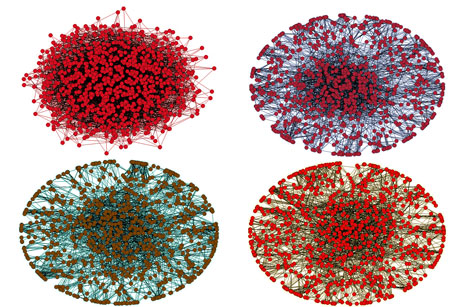by Jim Duggan
Our modern world is complex, and comprises a multitude of natural, engineered and social systems. The goal of this project is to design computational simulation approaches that can help us understand the way in which these systems interact, so that we can design better futures.
This research project, entitled Computational Methods for Modelling Complex Dynamic Systems, is a four-year research programme located in the College of Engineering and Informatics, at the National University of Ireland, Galway. Funded by Science Foundation Ireland , seven researchers are pursuing an interdisciplinary work programme to explore novel approaches to modelling complex social, economic and industrial systems. The core motivation for this research programme is to develop mathematical techniques that can help decision makers to: (i) understand the interconnected nature of our modern world; (ii) evaluate possible policy design alternatives in silico; and (iii) generate qualitative and quantitative insight into the possible future behaviours of these systems.
The project draws on three related methodological approaches for generating insight into economic and social systems:
• System Dynamics is a modelling approach based on the idea that systems can be understood by analysing their embedded feedback loops. These interlocking loop structures can be formulated as equations, and simulated using numerical algorithms. Feedback loops then can be formally analysed to demonstrate the impact of loop structures (for example, virtuous and vicious cycles prevalent in economics) on overall system behaviour.
• Agent-Based Computational Modelling is a complimentary approach to feedback modelling, where the unit of representation is an individual (or agent), and individuals have states (physical and psychological) and a range of behaviours. Individual decisions are based on an agent’s state space, and information from their immediate network is also considered. The key idea of the agent approach is to generate macroscopic explanations from local behaviours. For example, in the property market, an agent-based model could represent individual consumer behaviours, and from that, generate an explanation of the recent boom and bust cycle.
• Multi-Agent Systems and Game Theory put the focus on how to combine the efforts of many autonomous agents, where each has different information and separate goals. Game theory is an essential technique for this analysis, as it provides the basis for the mathematical investigation of interactions between independent, self-interested agents. Within game theory, games can be classified as being non-cooperative or cooperative, and the application areas include economics, political science and computer science.
In the research project, these three valuable perspectives are integrated through a multi-method simulation workbench. At its core is a numerical integration algorithm, which acts on a very large set of equations, where each equation represents a state of behaviour of an individual in the population. Different agent types can be designed, and any number of these agents (within the resource limit of the machine) can be instantiated. For each simulation, an appropriate network structure is selected. The options include the classic network types such as small world, lattice, grid, random and scale free, and the user also has the opportunity to create a hybrid network structure based on any combination of these standard representations. Once a model has been simulated, the results can be analysed at macro and micro level, including information on agent state changes, and also how the social networks may have evolved.
Sample output from a simulation is shown in Figure 1. This visualizes the spatial structure of a network, and how it dynamically evolves over time. Starting in the northwest quadrant with a random network, in our novel network algorithm individual nodes seek out new acquaintances, and from these local actions, the overall network evolves to take on the properties of a small world network. This approach is valuable for exploring the impact of dynamic social networks on the convergence of social norms.

Figure 1: From random to small world – the evolution of a dynamic social network.
In order to inform the design of this workbench, the project draws on the literature of thoroughly explored and well documented complex problems. These include: the beer game, developed at MIT, which explores the impact of misperceptions in decision making across connected industrial systems; epidemiology-inspired dynamics, such as norm evolution in society, the tipping points for new product introductions, and the spread of infectious diseases; and commons-type problems where the challenge is to optimally share limited resources amongst a population of self-interested agents. The project has also identified the potential for applying these underlying computational techniques to games development, and has developed strong collaborative linkages with scientists and creative writers with a view to working in the genre known as serious games for young children and teenagers.
The project is now just past its midpoint, and a library of algorithms and computational methods has been designed and developed. To date, these have been tested on well-defined problems. Future work will concentrate on real-world case studies, and will focus on gathering empirical data (eg social networks, industrial supply chains, epidemiology data) and constructing models to help generate insight into the behaviour of complex social systems.
Link:
http://corrib.it.nuigalway.ie
Please contact:
Jim Duggan
National University of Ireland, Galway.
Tel: +353 91 493 336
E-mail:










